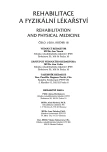Pařík O., Hojka V., Kračmar B.: Surface Tension of Individual Muscles during Athletic Sprint and Skipping
Authors:
O. Pařík; V. Hojka; B. Kračmar
Authors‘ workplace:
Katedra sportů v přírodě FTVS UK, Praha, děkan doc. PhDr. V. Süss, CSc.
Published in:
Rehabil. fyz. Lék., 18, 2011, No. 1, pp. 25-31.
Category:
Original Papers
Overview
This paper deals with the measurement of an electromyography record of surface tension of selected muscles during athletic sprinting and during special running exercise. We measured sprint and special running exercise on a thirty-meter-long track. The movement was also recorded on a synchronized video recording from a sideway camcorder. The aim of the paper was to describe how individual muscles participate in the mentioned moves but first of all how they participated during execution of the special running exercise. The second aim was to describe how similarly the muscles are participating during the special running exercise according to the targeted movement – sprinting. After that it possible to set and to describe how exercise is approaching with its content to the targeted movement and simultaneously it is accomplishing the requirements of the exercise which is special and not universally developing. The presumption is that the special running exercise will accomplish the role of special developing exercise only in some parts of the movement in which way it is used for.
Key words:
electromyography, sprint, special running exercise
Sources
1. ČIHÁK, R.: Anatomie I. Praha, Grada Publishing, 2006.
2. DE LUCA, C. J.: The use of surface electromyography in biomechanics. The international society for biomechanics. [on-line]. [cit. 10.11.2007]. Dostupné na: http://www.delsys.com/2003.
3. DERRICK, T. R., THOMAS, J. M., Chapter Z.: Time-series analysis: The crosscorrelation function. In: Innovative Analyses of Human Movement, 2004, s. 189-205.
4. MERLETTI, R., PARKER, P.: Electromyography. New Persey, John Wiley & Sons, Inc., Hobojem, 2004. ISBN 0-471-67580-6.
5. STERGIOU, N. (ed).: Human kinetice. Publisher. Champaign, Illinois, s. 189-205.
6. TRAVELL, J. G., SIMONS, D. G.: Myofascial pain and dysfunction: the triggerpoint manual. Baltimore, Williams & Wilkins, roč. 2, 1999.
7. Véle, F.: Kineziologie. Praha, Triton, 2006.
Labels
Physiotherapist, university degree Rehabilitation Sports medicineArticle was published in
Rehabilitation & Physical Medicine

2011 Issue 1
Most read in this issue
- Pánek D., Čemusová J., Pavlů D.: Diaphragm Paresis and Its Kinesiologic Consequence
- Horáček O., Schreier B., Lisý J., Kobesová A., Kolář P.: Application of Neurophysiological Procedures in Neurogenic Pareses of Abdominal Wall
- Benešová M., Holubářová J., Pánek D., Pavlů D.: The Use of Proprioceptive Neuromuscular Facilitation in Patients with Desault Fixation of Shoulder Joint
-
SVALOVÉ SYNERGIE HORNÍ KONČETINY:
POLYEMG STUDIE PRO KLINICKOU PRAXI
